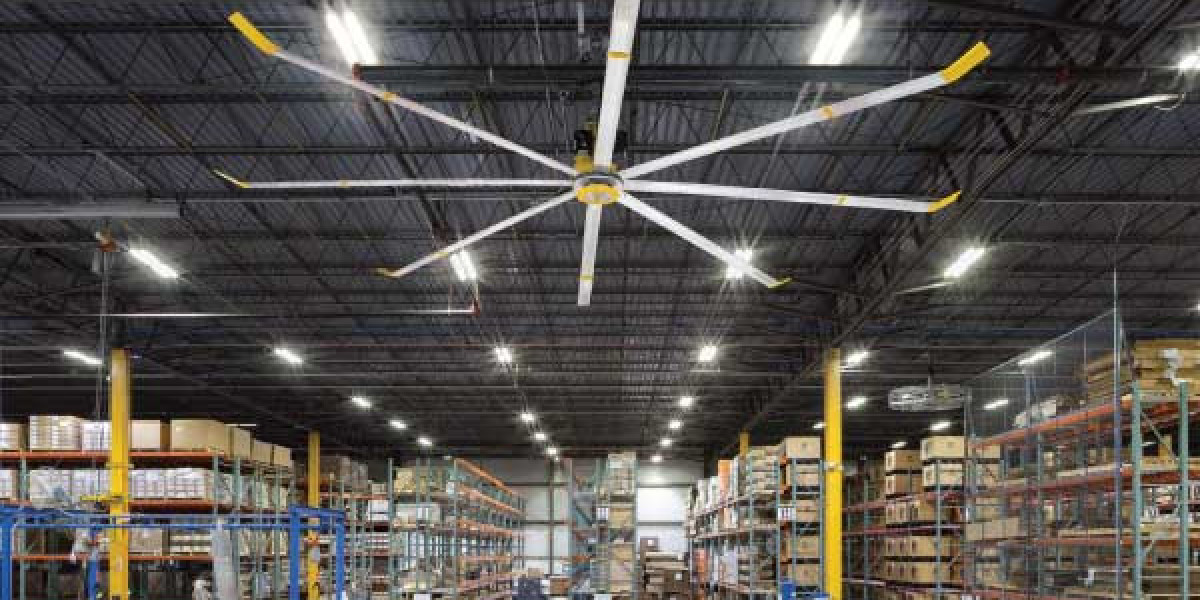Proper ventilation and air movement are critical in warehouse environments. From regulating temperature to improving worker comfort and energy efficiency, fans play a big role in maintaining an optimal working environment. Two of the most popular choices for warehouses are HVLS (High-Volume, Low-Speed) fans and high-speed fans. While both serve the same general purpose, they work differently and suit different needs. This guide will help you understand the differences so you can choose the right fan for your warehouse.
1. Understanding the Basics
HVLS Fans
HVLS fans are large-diameter fans, often ranging from 8 to 24 feet across. They move massive amounts of air at low speeds, creating a gentle but consistent breeze that covers large spaces. They’re ideal for wide, open areas that require even air distribution.
High-Speed Fans
High-speed fans, on the other hand, have smaller diameters (usually 3 to 6 feet) and spin at a much faster rate. They create concentrated airflow, making them effective at cooling specific zones or workstations rather than entire warehouse floors.
2. Airflow and Coverage
HVLS Fans – Provide broad, slow-moving air circulation. Perfect for reducing temperature differences between floor and ceiling (known as destratification). One HVLS fan can replace several smaller fans in large areas.
High-Speed Fans – Deliver powerful, directional airflow to targeted spots. They are great for areas where workers stay in one place for extended periods.
3. Energy Efficiency
HVLS Fans – Highly energy-efficient for large-scale cooling. Their low-speed motors use less electricity, and their wide coverage can reduce the need for air conditioning.
High-Speed Fans – Can be less efficient when trying to cool large spaces, as multiple units may be required to cover the same area as a single HVLS fan. However, they are effective for quick, localized cooling.
4. Impact on Comfort and Productivity
HVLS Fans – Create a steady breeze that can make temperatures feel 6–8°F cooler, improving comfort without causing disruptive wind gusts. They also help control humidity and improve indoor air quality.
High-Speed Fans – Provide instant relief in hot zones, which is useful for workers in high-heat environments such as near machinery or ovens.
5. Installation and Maintenance
HVLS Fans – Require more ceiling space and structural support due to their size. Professional installation is recommended. Once installed, they require minimal maintenance.
High-Speed Fans – Easier to install, even in smaller areas or on walls. Maintenance is straightforward, though multiple units may mean more upkeep over time.
6. Cost Considerations
HVLS Fans – Higher initial investment, but long-term savings come from lower energy bills and fewer units needed.
High-Speed Fans – Lower upfront cost per unit, but total cost can rise if many are needed to cover a large warehouse.
7. When to Choose HVLS Fans
Your warehouse is large and open with high ceilings.
You need even airflow distribution across the entire facility.
Energy efficiency is a top priority.
You want year-round benefits—HVLS fans can push warm air down in winter to reduce heating costs.
8. When to Choose High-Speed Fans
You have specific hot zones or areas needing targeted cooling.
Ceiling height or space limitations make HVLS installation difficult.
You need a quick, budget-friendly solution for improving airflow in certain sections.
9. The Best Approach: Sometimes Both
In many cases, the most effective warehouse ventilation strategy uses both HVLS and high-speed fans. The HVLS fans handle overall circulation and destratification, while high-speed fans provide focused cooling in specific high-heat or high-traffic zones. This combination ensures balanced airflow, maximum comfort, and optimal energy efficiency.
Conclusion
Choosing between HVLS and high-speed fans for warehouse depends on your warehouse’s size, layout, cooling needs, and budget. HVLS fans excel at whole-warehouse air circulation and long-term efficiency, while high-speed fans shine in targeted cooling applications. For many warehouses, a blended approach offers the best results—ensuring workers stay comfortable, energy costs stay low, and operations run smoothly year-round.













